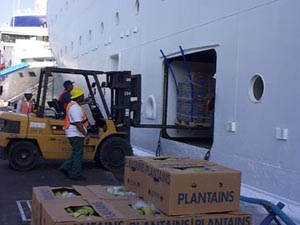Forklift
Forklift is a powerful industrial truck used to lift and move materials over short distances. The history of the forklift is intertwined with the evolution of logistics and warehousing operations, with its development significantly enhancing the efficiency of material handling processes. Forklifts are indispensable in the operations of warehouses, construction sites, and various manufacturing environments, where they contribute to the streamlined movement of goods and materials.
History[edit | edit source]
The forklift as we know it today has evolved from its humble beginnings in the early 20th century. Initially, manual and powered hoists were used for lifting materials. The introduction of the powered lift truck in the 1910s marked the beginning of the forklift's development. The need for increased material handling efficiency during World War I and World War II catalyzed significant advancements in forklift technology, including improvements in lifting capacity and the introduction of the hydraulic lifting mechanism.
Types of Forklifts[edit | edit source]
There are several types of forklifts, each designed for specific applications and environments:
- Counterbalance Forklifts: The most common type, with forks at the front and a weight at the back to balance the load.
- Reach Trucks: Designed for warehousing operations, these forklifts have an extended reach mechanism to lift loads to higher racks.
- Pallet Jacks: Also known as pallet trucks, these are manual or powered trucks designed to lift and move pallets.
- Rough Terrain Forklifts: Equipped with special tires and a robust design, these forklifts are suitable for outdoor construction sites and uneven surfaces.
- Telescopic Handlers: Also known as telehandlers, these are equipped with a telescopic boom, making them suitable for tasks that require high reach and versatility.
Safety[edit | edit source]
Safety is a paramount concern in the operation of forklifts. Operators are required to undergo specialized training to understand forklift operation, safety procedures, and the specific handling characteristics of the forklift they will be operating. Common safety practices include regular maintenance checks, adherence to load capacity limits, and the use of personal protective equipment (PPE). Workplace safety regulations and guidelines, such as those provided by the Occupational Safety and Health Administration (OSHA) in the United States, set standards for forklift operation to minimize the risk of accidents and injuries.
Forklift Operation[edit | edit source]
Operating a forklift involves several key functions: steering, lifting and lowering loads, and maneuvering through tight spaces. The complexity of forklift operation necessitates comprehensive training, which covers the mechanical operation of the forklift, safety practices, and the specific handling characteristics of different types of loads. Operators must also be aware of their environment, including the layout of the workspace, the presence of other workers, and potential hazards.
Maintenance[edit | edit source]
Regular maintenance is crucial to ensure the safe and efficient operation of forklifts. Maintenance tasks include checking the hydraulic system, brakes, steering components, and lifting mechanisms, as well as ensuring that all safety devices are functional. Proper maintenance not only extends the lifespan of the forklift but also prevents accidents caused by mechanical failure.
Environmental Considerations[edit | edit source]
The environmental impact of forklifts, particularly those powered by internal combustion engines, includes emissions that can contribute to air pollution. Electric forklifts offer a more environmentally friendly alternative, with lower emissions and reduced noise levels. Advances in battery technology and the increasing availability of renewable energy sources are making electric forklifts an increasingly viable option for sustainable material handling.
Transform your life with W8MD's budget GLP1 injections from $125
W8MD offers a medical weight loss program NYC and a clinic to lose weight in Philadelphia. Our W8MD's physician supervised medical weight loss centers in NYC provides expert medical guidance, and offers telemedicine options for convenience.
Why choose W8MD?
- Comprehensive care with FDA-approved weight loss medications including:
- loss injections in NYC both generic and brand names:
- weight loss medications including Phentermine, Qsymia, Diethylpropion etc.
- Accept most insurances for visits or discounted self pay cost.
- Generic weight loss injections starting from just $125.00 for the starting dose
- In person weight loss NYC and telemedicine medical weight loss options in New York city available
- Budget GLP1 weight loss injections in NYC starting from $125.00 biweekly with insurance!
Book Your Appointment
Start your NYC weight loss journey today at our NYC medical weight loss, and Philadelphia medical weight loss Call (718)946-5500 for NY and 215 676 2334 for PA
Search WikiMD
Ad.Tired of being Overweight? Try W8MD's NYC physician weight loss.
Semaglutide (Ozempic / Wegovy and Tirzepatide (Mounjaro / Zepbound) available. Call 718 946 5500.
Advertise on WikiMD
|
WikiMD's Wellness Encyclopedia |
| Let Food Be Thy Medicine Medicine Thy Food - Hippocrates |
Translate this page: - East Asian
中文,
日本,
한국어,
South Asian
हिन्दी,
தமிழ்,
తెలుగు,
Urdu,
ಕನ್ನಡ,
Southeast Asian
Indonesian,
Vietnamese,
Thai,
မြန်မာဘာသာ,
বাংলা
European
español,
Deutsch,
français,
Greek,
português do Brasil,
polski,
română,
русский,
Nederlands,
norsk,
svenska,
suomi,
Italian
Middle Eastern & African
عربى,
Turkish,
Persian,
Hebrew,
Afrikaans,
isiZulu,
Kiswahili,
Other
Bulgarian,
Hungarian,
Czech,
Swedish,
മലയാളം,
मराठी,
ਪੰਜਾਬੀ,
ગુજરાતી,
Portuguese,
Ukrainian
Medical Disclaimer: WikiMD is not a substitute for professional medical advice. The information on WikiMD is provided as an information resource only, may be incorrect, outdated or misleading, and is not to be used or relied on for any diagnostic or treatment purposes. Please consult your health care provider before making any healthcare decisions or for guidance about a specific medical condition. WikiMD expressly disclaims responsibility, and shall have no liability, for any damages, loss, injury, or liability whatsoever suffered as a result of your reliance on the information contained in this site. By visiting this site you agree to the foregoing terms and conditions, which may from time to time be changed or supplemented by WikiMD. If you do not agree to the foregoing terms and conditions, you should not enter or use this site. See full disclaimer.
Credits:Most images are courtesy of Wikimedia commons, and templates, categories Wikipedia, licensed under CC BY SA or similar.
Contributors: Prab R. Tumpati, MD







